Baby formula usually has enough to cope with courtesy of the breast is best brigade, but 2013 has been even more controversial than usual for the powdered stuff. Yet although chaos reigned, sales soared [Nielsen 52 w/e 12 October].
In April, the Fonterra botulism scare rocked the industry to its core. It turned out to be a false alarm, but it cost the industry millions. And although it didn’t impact this country, a more bizarre turn of events did.
Read The Grocer’s full Top Products Survey.
In an extraordinary development, wartime-style rationing of infant formula was introduced in the UK as overwhelming demand from China, which has an inherent mistrust of domestically made formula following the melamine scandal in 2008, meant UK shelves were at risk of being stripped bare as Chinese tourists and students bought in bulk to sell the product for triple the price back home.
According to the Daily Mail, at least. ‘Mothers in a panic as stores sell out’ it screamed in April as Tesco, Asda, Sainsbury’s and Morrisons all introduced a maximum of two 900g tins of Aptamil or Cow & Gate milk per visit.
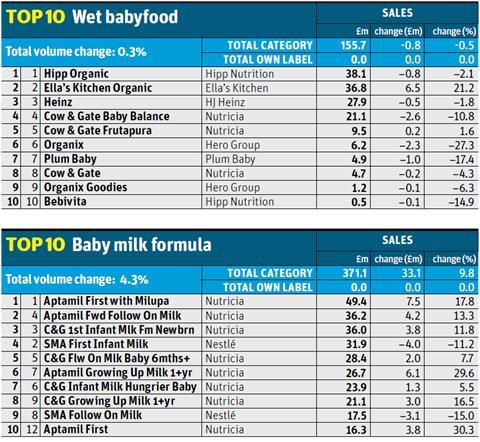
Despite the turmoil, value growth of 9.8% on volumes up 4.3% suggest 2013 was, then, a year to remember for the category. Premium brand Aptamil enjoyed the most success, with Aptamil First with Milupa retaining top spot and Forward Follow On milk moving up from 4th to 2nd, seeing value uplifts of 17.8% and 13.3% respectively. “We have continued our year-on-year success for Aptamil in 2013 through unrelenting product innovation,” says a spokesman for Aptamil. “Pioneering research into the composition and benefits of breast milk has enabled us to develop and launch our most advanced formula yet.”
Referring to the rationing, he added: “Cross-border trading caused some availability issues, which have been managed to minimise the impact on UK mums and babies.”
Elsewhere, in wet babyfood, Ella’s Kitchen continues to fly. Value is up 21.2% volumes are up 21.8%. “We expanded our product offering with the launch of our first range for babies over 12 months,” explains a spokesman. “We always strive to innovate, to be thought leaders, to be thinking ‘what’s next?’”
Hipp Organic narrowly holds on to top spot, despite a 2.1% fall in value and a 0.1% volume dip. However, a spokesman says there’s still reason for cheer. “We’ve had great gains in tray meal and pouch sales. Hipp Tray meals have grown 3.4% despite a 0.8% decline in the category overall, while Hipp pouches have seen an impressive 110% sales growth year on year.”
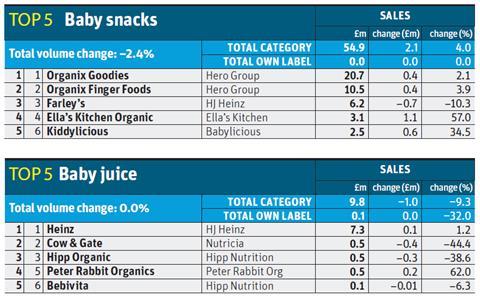
Cow & Gate had a more mixed year in wet babyfood but is fighting back, extending its range of pouches by launching a further six fruit varieties. “The pouch format was a game changer when it was first introduced, and has continued to grow over recent years,” says a spokeswoman for Cow & Gate. “It’s perceived as providing added convenience versus the more traditional jar. Mums are willing to pay a premium for the added convenience offered by this simple format change.”
Heinz would agree. It doubled its booming pouch range in May following its launch into the category in January.
Meanwhile the snack category is ruled by Organix, which takes the two top spots with Goodies and Finger Foods. Value for both is up (2.1% and 3.9% respectively), and its organic approach is paying dividends. “Organic babyfood is in 5% growth and accounts for 55% of the babyfood market,” says a spokeswoman. “Conversely, the non-organic sector continues in 4% decline for the second consecutive year.”
The final subcategory is baby juice. The category as a whole is down 9.3%, significantly worse than last year’s 2.3% decline. As with last year, the main drag is caused by own-label products, which plunged 32% in value, also worse than last year’s 27.5% decline. The emerging performance of the wholesome Peter Rabbit Organics is the silver lining, with sales soaring thanks to a tie-up with CBeebies, which a spokesman says provided “strong brand awareness and recognition” at sampling events like The Baby Show. It also secured new listings with its 150ml juice carton range and saw “strong distribution gains across multiple grocers in 2013, which we are looking to improve on during 2014”.
So it’s been a mixed year for babyfood. Although powdered milk may have emerged in a stronger position than before, it will probably hope 2014 is a little more serene. However, the fact it hit the headlines yet again in November, when the government proposed rewarding breastfeeding mums with store vouchers while formula mums were left empty-handed and angry, suggests controversy is unlikely to ever stay far away.
Read The Grocer’s full Top Products Survey.
Top launch: Heinz Pouches, Heinz
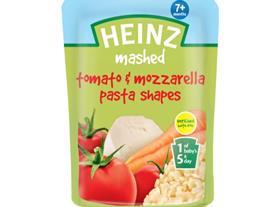
Heinz finally woke up to the burgeoning popularity of pouches in January, when it released a 10-strong range. It hoped to grab a 1.9% share of the market, but ended up with 3.9% instead. Bolstered by booming sales, it has doubled the range to 20 varieties. Its popularity is down to two key factors, the inherent mainstream appeal of a household name like Heinz, but also the fact the range of sweet and savoury pouches were pitched 10% to 20% cheaper than rivals.




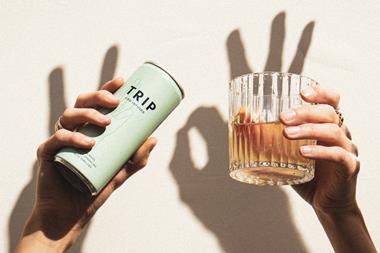
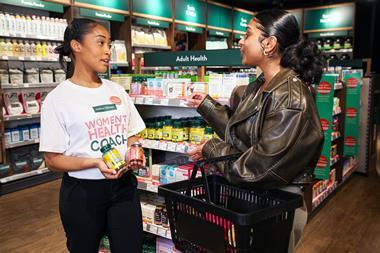
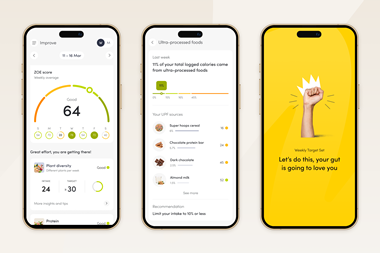


No comments yet